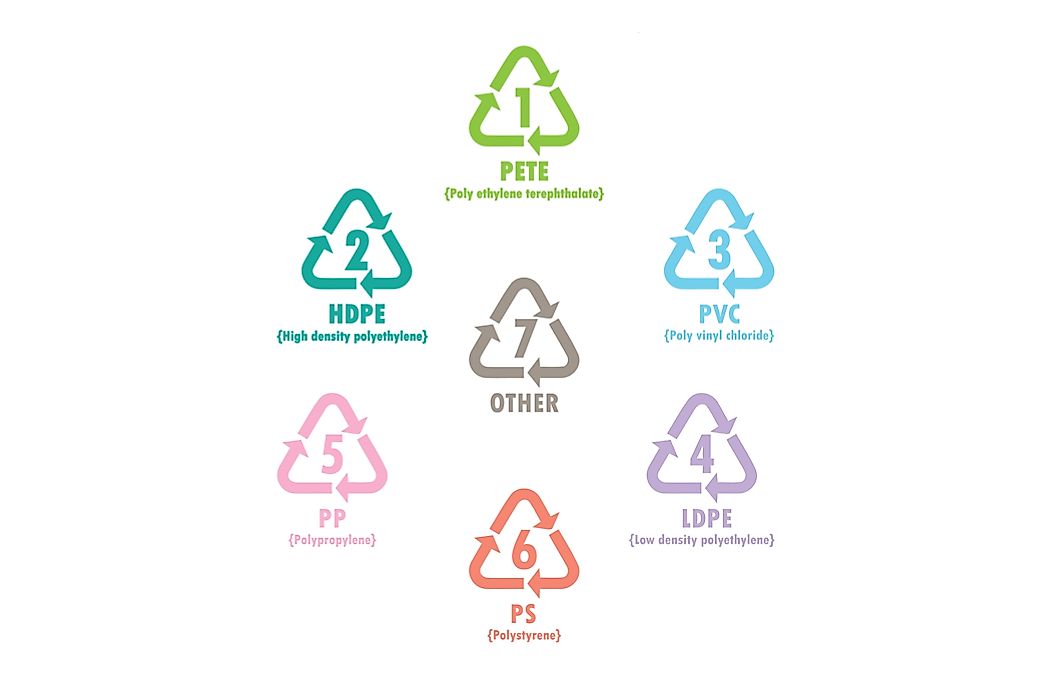What Types of Plastics Are Recyclable?

Recycling plastic is a process that involves the conversion of waste plastic into useful materials. The process includes collecting the recyclable plastics, sorting them according to their respective polymers, and then melting them down into pellets that can be used to make items such as plastic cups, chairs, tables, and polythene bags. Recycling of plastics has been done since the 1970s. The practice is encouraged to protect the environment. Below are the recyclable plastics.
RIC 1: Polyethylene Terephthalate (PETE or PET)
PET is widely used for soft drink bottles as it makes an excellent moisture barrier. When recycling PETE, the plastic containers are sorted by color. They are then washed and flaked. As the process continues, non-PETE components are eliminated. After flaking, the clean PETE is dried up. The recycled plastic are passed through several treatment process that would make them safe to be used in food handling. The treatment processes include melt filtering and pelletizing. One of the most popular uses of a recycled PET is manufacturing fabrics for the clothing and textiles industries. The fabrics are produced when the recycled flake is spun through yarn and thread. Due to the irritation, the fabric may cause, the fabric is used to make clothes do not in direct contact with the skin such as jackets and coats. Besides, they are used to make containers such as bottles and food tins.
RIC 2: High-Density Polyethylene (HDPE or PE-HD)
The high-density polyethylene is usually in high demand when it is recycled. Its resin identification code is 2. The materials that is used to make the polythene are usually strong and durable. HDPE is used to make items such as plastic rulers, hula hoop rings, toiletry packaging containers, roadside curbs, benches, tables, and liners of cargo trucks. They are popular due to the safety they guarantee the users. The material does not transmit any chemicals to the foods and drinks that are stored in them.
RIC 3: Polyvinyl Chloride (PVC or V)
Polyvinyl chloride is designated a resin identification code of 3.It is versatile and when recycled, it can be used to manufacture a variety of products. Besides, it is very strong and tough. It is used to make packaging containers, electricity installation cables, and rigid pipes. They are also used to make credit cards and synthetic leather.
RIC 4: Low-Density Polyethylene (LDPE or PE-LD)
With a resin identification code of 4, low-density polyethylene is popular due to its attributes. First, it is easy to process and recycle. Secondly, it is strong and tough, thirdly, after it is recycled, the plastic is usually flexible. Its resistance to moisture makes it more popular. If recycled, it can be used to make flexible container lids, squeezable bottles, and frozen food bags.
RIC 5: Polypropylene (PP)
The resin identification code of polypropylene is 5. Polypropylene is strong, tough, heat-resistant, and versatile. It can be recycled to make reusable microwave containers, kitchen utensils, disposable food containers, and soft drink bottles. Its ability to withstand higher temperatures makes it more popular.
RIC 6: Polystyrene (PS)
Polystyrene has a resin identification code of 6. It is versatile and mostly used in the manufacturing of clear plastics such as disposable cups, trays, packing containers, and egg cartons. It is not so popular compared to other recyclable plastics due to the difficulty in its recycling process.
RIS 7: Other Types of Plastics
Other plastics that can be recycled are designated the resin identification code 7. The most popular plastics in this category is polycarbonate and polylactide. They are mostly used in the manufacturing of baby milk bottles, riot shields, plastic toys, sunglasses lenses, and automotive headlamps. These plastics are also difficult to recycle.
What Types of Plastics Are Recyclable?
| Resin identification code | Abbreviation | Polymer Name |
|---|---|---|
| 1 | PETE or PET | Polyethylene terephthalate |
| 2 | HDPE or PE-HD | High-density polyethylene |
| 3 | PVC or V | Polyvinyl chloride |
| 4 | LDPE or PE-LD | Low-density polyethylene |
| 5 | PP | Polypropylene |
| 6 | PS | Polystyrene |
| 7 | OTHER or O | Other types of plastics or combination plastics |











